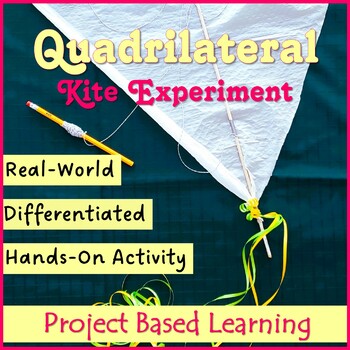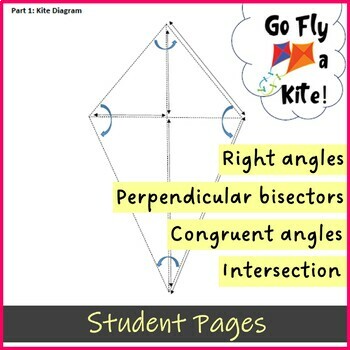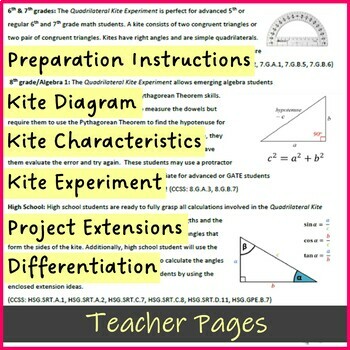Quadrilateral Kite Experiment Project Congruent Angles & Perpendicular Bisectors
- PDF
What educators are saying
Description
The purpose of the Quadrilateral Kite Experiment is to allow students to explore the characteristics of a quadratic kite and use those properties for flight. Students will construct a kite using wooden dowels, a plastic bag, and some string. They will conduct an experimental flight, recording their data and results. Students will then reflect on their results and the qualities of a quadratic kite that make it the choice shape for flight. They will then examine the results of others.
Students will:
1. Construct a kite made of wooden dowels, a plastic bag, and string.
2. Measure and calculate kite dimensions.
3. Prove that their creation has the characteristics of a quadratic kite.
4. Conduct an experimental flight.
5. Accurately record results and adjust as needed.
6. Reflect on successes and failures.
7. Use a rubric to assess the work of another student team.
The Quadratic Kite Experiment has built in differentiation making it appropriate for students in 6th, 7th, and 8th grade and high school. Students should already know how to: measure with precision, recognize a right angle, and use a protractor. (High school students do not need a protractor.) The project is leveled to include work with the Pythagorean Theorem for 8th grade and Algebra 1 students. High school students will include work with trigonometric functions. Students will need two hours to fully complete the construction of the kite, the mathematical calculations, the kite flight experiment, and the project reflection. This task addresses the following common core standards: 6.G.A.1, 6.G.A.2, 7.G.A.1, 7.G.B.5, 7.G.B.6, 8.G.A.3, 8.G.B.7, HSG.SRT.A.1, HSG.SRT.A.2, HSG.SRT.C.7, HSG.SRT.C.8, HSG.SRT.D.11, HSG.GPE.B.7, MP1, MP2, MP3, MP4, MP5, and MP6.
For more Project Based Learning with Mathematics available at my store: https://www.teacherspayteachers.com/Store/Absolute-Value. This project was created and provided by Absolute Value.
**************************************************************************************************
Customer Tips: How to get TPT credit for future purchases:
Go to your “My Purchases” page. Next to each purchase, you'll see a “Provide Feedback” button. Simply click it and you will be taken to a page where you can give a quick rating and leave a short comment for the product. Each time you give feedback, TPT gives you feedback credits that you may use to lower the cost of your future purchases. I'd really love it if you'd rate the resource after downloading! Feedback is so VERY important!
**************************************************************************************************
Follow my Store
Click on the green star next to my store logo to receive upcoming sales, freebie and product launches, and email updates!
Here's to a successful year!
Absolute Value
Wendy Petty
Petty415@gmail.com





